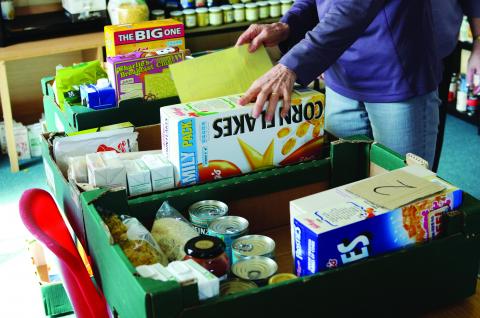14 February 2024
Food Prices Tracker: February 2024

By Josh Day
Food inflation falls to 7% (CPIH) according to government data
Data released today from the Office of National Statistics finds that overall inflation has remained at 4% (CPI) in the 12 months to January 2024. Food inflation has continued to ease, falling to 7% (CPIH). High food inflation has been a major contributor to rising overall inflation and recent decrease have played a large part in inflation slowing. However, inflation that remains above 0% indicates that prices are still continuing to rise but at a slower rate.
The Basic Basket
Although food inflation has slowed, food prices still remain high, and this continues to have a significant impact of people struggling across the UK. The Food Foundation’s Basic Basket is a shopping basket tracker to measure weekly price changes in what the average man and woman could typically eat as part of a reasonably costed, adequately nutritious diet (see FAQs for further details). We have been tracking the cost of the Basic Basket since April 2022. Since then, the woman’s basket of food has increased in price by 23.9%, now costing £50.77 per week. The male basket has increased by 25.5% (non-clubcard price) and currently costs £54.64 per week. This illustrates how though we may see lower rates of inflation, the reality for many is that the cost of food remains high.
What is HCI and how is it different to other inflation measures
Earlier this month, the ONS released the first quarterly HCI (Household Cost Indices) data, a new measure of inflation that provides insight into how changing prices affect different groups of the population. The ONS have been developing this index for some time, with the first preliminary release back in 2017 following a report that outlined the need for an inflation measure that more accurately showed how households experienced inflation.
The new quarterly releases of HCI data present an opportunity to understand how inflation is experienced by people across the UK. There are several factors that make it distinct from CPI (Consumer Price Index) and CPIH (Consumer Price Index including Housing costs), the UK’s official inflation measures. One of the main ways that HCI differs from CPI and CPIH is that HCI uses a ‘democratic’ weighting system, meaning different items in the basket of goods used to measure inflation are weighted by the average households’ expenditure allowing for the representation of different households’ experience of inflation . HCI recognises that inflation is not experienced equally across all items and households; different households will spend larger amounts of their income on different items meaning inflation of those particular items is experienced more by some than for others. Another major difference is the way that a variety of household costs (such as changes in mortgage interest rates and stamp duty) are accounted for – these are not included in the CPI inflation measurement and are measured differently in the CPIH measurement. This further opens up the possibility of a more realistic view of how inflation is actually felt by households and particularly by different household groups who will spend varying amounts of their income on these items.
The result of these differences is that HCI sits significantly higher than the CPIH figure, at 8.2% (HCI) compared to 6.3% (CPIH) in the 12 months leading to September. This shows that by this new measure, the average household is experiencing inflation at a higher rate than the CPI/CPIH measures indicate, and this is particularly true for lower income households.HCI allows for us to look at how inflation is experienced by different household groups. One of the ways that this can be done is by income decile.
Although HCI, for people in income decile 2 and 9 (decile 1 and 10 have not been used here to represent low vs high income households as these groups can contain unusual spending which can create misleading data sets) has converged in recent months, increases in household costs peaked earlier in October 2022, with low-income households (decile 2) experiencing an annual inflation rate of 13.5% (HCI). This is 2.0 percentage points higher than the rate of inflation experienced by high-income households (decile 9). This is due to the fact that lower income households have to spend a much larger amount of their income on both food and energy which both saw dramatic increases in inflation during this time. This data shows that lower income households have been experiencing inflation at a higher rate than higher income households during the cost-of-living crisis. It raises concern that the leading measure of inflation in the UK does not reflect the true experience of thousands across the UK, especially those on lower incomes who are the most vulnerable to dramatic increases in inflation particularly food and energy inflation.
Though we have seen inflation come down in recent months food inflation remains high. We know that those on lower incomes experience food price inflation more than higher income families because they must spend a larger proportion of their income on food than higher income households. The recent HCI data moves towards a more accurate representation of this experience. During the peak of the cost-of-living crisis HCI shows that food and non-alcoholic beverages had an increasing contribution to the difference in inflation for low- and high-income households In March 2023 the contribution of food inflation to the 2% difference in inflation for decile 2 and 9 peaked at 0.85% (see figure 4 here). Though the contribution of food inflation fell to 0.52 percentage points in September 2023 , food and non-alcoholic beverages inflation is now the largest contributor to higher inflation for low-income households.
Though CPIH is the ONS’ most comprehensive inflation measure and works well for broader economic purposes the Royal Statistical Society have stressed the importance of the HCI as an additional tool which is essential for understanding the different experiences of inflation in households across the UK. Benefits are uprated in line with inflation each year based on CPI which the HCI shows is more reflective of inflation as experienced by higher income households. This is resulting in benefits that are falling of short of the impact that inflation is having on low-income households. A recent research paper by Prof Donald Hirsch showed that benefits levels no longer provided enough money for people “to function day to day and have healthy lives”. The report showed that for a single adult in 2023 food and energy costs amounted to 22% more than the amount their benefits provided. The HCI inflation measure allows us to see, in stark detail, the difference between the household experience of inflation for lower income families and the benefits they can receive. Government must ensure that policies are made to serve every person in the UK. The ONS’ HCI measure creates the opportunity to see how inflation is felt across the UK by different household groups and to create policies that take into account how different people are experiencing price inflation.

Josh joined The Food Foundation in 2023 as part of the Rank Foundation’s Time to Shine scheme. He completed a BA in Film Studies before continuing to study an MA in Culture and Critical Theory. Before moving to The Food Foundation Josh worked in a variety of roles in a primary school setting, utilising his experience to support the most vulnerable and disadvantaged members of the school community. Josh is interested in the impact that food systems and environments have on people's lives and is driven by a desire to ensure people have better access to a healthy and nutritious diet.

Shona joined The Food Foundation as a Project Officer in 2019 and has worked on research, policy and advocacy across a range of projects over that time including leading our food insecurity surveys and flagship annual Broken Plate reports. She now works across the charity's policy portfolio including our children's food campaigns, food insecurity and food environments. She is a Registered Associate Nutritionist with a background in clinical nutrition who worked in dietetic departments in NHS hospitals before joining The Food Foundation.

Indu joined The Food Foundation in 2019 as part of the Rank Foundation’s Time to Shine scheme, moving into a Project Officer role in 2020. She works on the Peas Please and Plating up Progress projects. Prior to joining The Food Foundation, Indu completed a MSc in Public Health and a BSc in Human Nutrition. She is interested in reducing health inequalities, children’s health and wellbeing, and sustainable and nutritious food system/diets. Indu is also a lover of veg, having recently taken up urban gardening.





